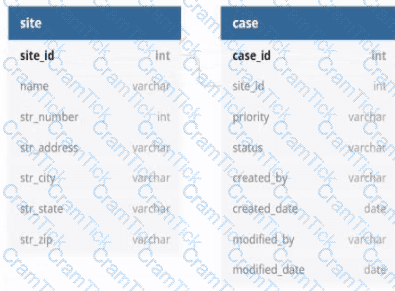Indexing columns can improve the performance of queries that use those columns in filters, joins, or order by clauses. In this case, the columns that should be indexed are site_id, status, and priority, because they are used for filtering or joining the tables. Site_id is used to join the case and site tables, so indexing it will speed up the join operation. Status and priority are used to filter the cases by the user’s input, so indexing them will reduce the number of rows that need to be scanned. Name, modified_date, and case_id do not need to be indexed, because they are not used for filtering or joining. Name and modified_date are only used for displaying information in the record grid, and case_id is only used as a unique identifier for each record. Verified References: Appian Records Tutorial, Appian Best Practices
As an Appian Lead Developer, optimizing a database view for an entity-backed record grid requires indexing columns frequently used in queries, particularly for filtering and joining. The scenario involves a record grid displaying cases with site information, filtered by “priority level” and “status,” and joined via the site_id foreign key. The image shows two tables (site and case) with a relationship via site_id. Let’s evaluate each column based on Appian’s performance best practices and query patterns:
A. site_id:This is a primary key in the site table and a foreign key in the case table, used for joining the tables in the view. Indexing site_id in the case table (and ensuring it’s indexed in site as a PK) optimizes JOIN operations, reducing query execution time for the record grid. Appian’s documentation recommends indexing foreign keys in large datasets to improve query performance, especially for entity-backed records. This is critical for the join and must be included.
B. status:Users filter cases by “status” (a varchar column in the case table). Indexing status speeds up filtering queries (e.g., WHERE status = 'Open') in the record grid, particularly with large datasets. Appian emphasizes indexing columns used in WHERE clauses or filters to enhance performance, making this a key column for optimization. Since status is a common filter, it’s essential.
C. name:This is a varchar column in the site table, likely used for display (e.g., site name in the grid). However, the scenario doesn’t mention filtering or sorting by name, and it’s not part of the join or required filters. Indexing name could improve searches if used, but it’s not a priority given the focus on priority and status filters. Appian advises indexing only frequently queried or filtered columns to avoid unnecessary overhead, so this isn’t necessary here.
D. modified_date:This is a date column in the case table, tracking when cases were last updated. While useful for sorting or historical queries, the scenario doesn’t specify filtering or sorting by modified_date in the record grid. Indexing it could help if used, but it’s not critical for the current requirements. Appian’s performance guidelines prioritize indexing columns in active filters, making this lower priority than site_id, status, and priority.
E. priority:Users filter cases by “priority level” (a varchar column in the case table). Indexing priority optimizes filtering queries (e.g., WHERE priority = 'High') in the record grid, similar to status. Appian’s documentation highlights indexing columns used in WHERE clauses for entity-backed records, especially with large datasets. Since priority is a specified filter, it’s essential to include.
F. case_id:This is the primary key in the case table, already indexed by default (as PKs are automatically indexed in most databases). Indexing it again is redundant and unnecessary, as Appian’s Data Store configuration relies on PKs for unique identification but doesn’t require additional indexing for performance in this context. The focus is on join and filter columns, not the PK itself.
Conclusion: The three columns to index are A (site_id), B (status), and E (priority). These optimize the JOIN (site_id) and filter performance (status, priority) for the record grid, aligning with Appian’s recommendations for entity-backed records and large datasets. Indexing these columns ensures efficient querying for user filters, critical for the application’s performance.
[References: , Appian Documentation: "Performance Best Practices for Data Stores" (Indexing Strategies). , Appian Lead Developer Certification: Data Management Module (Optimizing Entity-Backed Records). , Appian Best Practices: "Working with Large Data Volumes" (Indexing for Query Performance)., , ]










